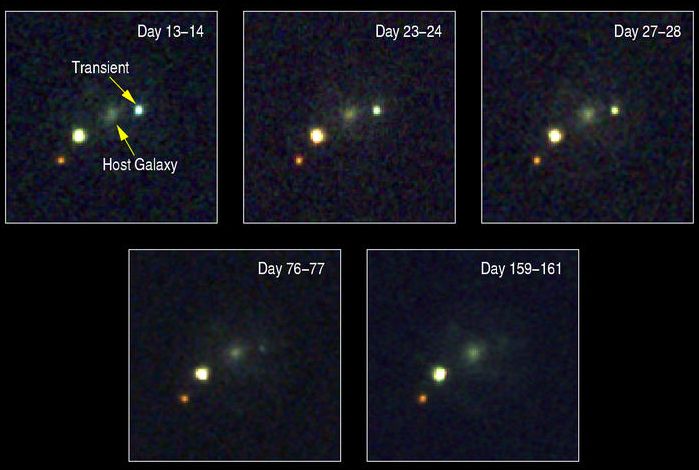
|
po tekstam po klyuchevym slovam v glossarii po saitam perevod po katalogu |
Explanation: On the 21st of November 2001, satellites detected yet another burst of gamma-rays from the cosmos. While this flash of high-energy photons lasted for less than a minute, eager astronomers have been following the fading optical light from the location of the burst source ever since. Seen above in a series of Hubble Space Telescope images recorded from December 4, 2001 to May 5, 2002 (13 through 161 days after the burst), the fading transient lies to the right of a fuzzy, distant galaxy, likely home to the gamma-ray burster. Two constant point-like objects to the left of the galaxy are foreground stars within our own Milky Way. The transient did not not simply fade away, though. Observations from the Hubble, OGLE, and the large Magellan telescope in Chile indicate that it bumped up or brightened again days after the burst in a convincing display characteristic of a supernova - the death explosion of a massive star. These results add to the mounting evidence that at least some of the mysterious cosmic gamma-ray bursts are produced in the violent event which ends the lives of massive stars.
1999 2000 2001 2002 2003 2004 2005 2006 2007 2008 2009 2010 2011 2012 2013 2014 2015 2016 2017 2018 2019 2020 2021 2022 2023 2024 2025 |
Yanvar' Fevral' Mart Aprel' Mai Iyun' Iyul' Avgust Sentyabr' Oktyabr' Noyabr' Dekabr' |
NASA Web Site Statements, Warnings, and Disclaimers
NASA Official: Jay Norris. Specific rights apply.
A service of: LHEA at NASA / GSFC
& Michigan Tech. U.
|
Publikacii s klyuchevymi slovami:
GRB 011211 - gamma-ray burst - supernova - SN 2001ke - gamma-vspleski - Sverhnovye - GRB
Publikacii so slovami: GRB 011211 - gamma-ray burst - supernova - SN 2001ke - gamma-vspleski - Sverhnovye - GRB | |
Sm. takzhe:
Vse publikacii na tu zhe temu >> | |
